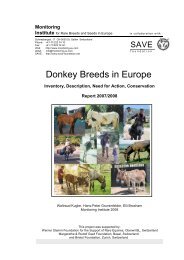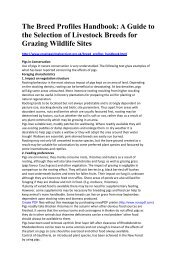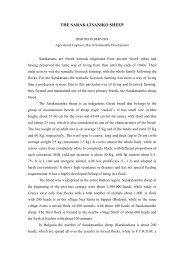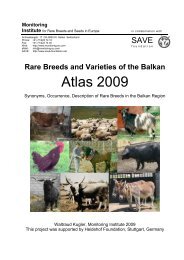THE AXIOS FERAL HORSES - Agrobiodiversity-Net
THE AXIOS FERAL HORSES - Agrobiodiversity-Net
THE AXIOS FERAL HORSES - Agrobiodiversity-Net
Create successful ePaper yourself
Turn your PDF publications into a flip-book with our unique Google optimized e-Paper software.
<strong>THE</strong> <strong>AXIOS</strong> <strong>FERAL</strong> <strong>HORSES</strong> (2008-2012)<br />
The feral horses of Axios’ river are an important part of the regional fauna that<br />
additionally attract the tourist’s attention. Due to the modernization of the agriculture<br />
the domestic horses of this area were left free, since they were not necessary for the<br />
ordinary work in the fields. The horses used to wander around the banks of Axios’<br />
river, where they found fertile ground and shelter to multiply their population,<br />
resulting after more than 5 decades in a robust trunk horse, the “Axios horse”, which<br />
has a very uniform conformation, medium height and phenotypic characteristics<br />
derived mainly from Thessalian, and Pindos ponies (and maybe from Thoroughbreds).<br />
However the local farmers complain that the horses damage their cultivations,<br />
especially during the periods of the river’s flood, when the horses are moving<br />
elsewhere for food and shelter.<br />
The Greek Society for the Protection and Preservation of Indigenous breeds of<br />
Domestic Animals “AMAL<strong>THE</strong>IA” executed a “SURVEY REGARDING <strong>THE</strong> POPULATION<br />
AND <strong>THE</strong> BEHAVIOUR OF <strong>AXIOS</strong> <strong>FERAL</strong> <strong>HORSES</strong>” in 2008 for SAVE FOUNDATION.<br />
The Survey was financed from the Greek Ministry of Environment through the Axios –<br />
Loudias – Aliakmonas Management Authority. The main aim of this project was to<br />
monitor the status of these horses and motivate the local community to accept their<br />
existence.<br />
Our research activities included count of the total horses’ population and the<br />
population of each herd using binoculars, and photo cameras from the ground and<br />
from the air with helicopter. Also were monitored the preferred locations where the<br />
horses use to gather, mate and reproduce, and were also assessed the social<br />
behaviour of these horses within their herds, the age range and sex distribution of<br />
the horse population and the rate of their multiplication. The foals and nursing mares<br />
and the elderly horses of each herd were counted. The Survey has been continued<br />
informally to this day by “AMAL<strong>THE</strong>IA” in order to monitor any changes in the status<br />
of the equine population.<br />
Conclusions<br />
• The total equine population in Axios region in 2008 was 67 individuals, i.e. 34<br />
males, 14 females, 7 of non-identified sex and 12 foals, forming 4 reproductive<br />
groups, 1 bachelor group and 3 isolated individuals (1 captured). In the years<br />
following the 2008 Survey, the population diminished resulting today in 40 horses<br />
i.e. 23 males and 17 mares forming two big distinguished groups. The east bank<br />
group included most of the bachelors. The west bank group is still in equilibrium.<br />
• The area where the horses live is restricted by natural and man-made obstacles<br />
(channel, river, fences) and by the expanded edible flora and salted areas.
• Extended degradation of the natural environment is caused by the existence of<br />
illegal farm premises, where considerable number of animals is kept, the old wire<br />
fences, and the contamination of the river by garbage. The large population of<br />
imported cattle in this area is the main cause of soil deterioration due to<br />
overgrazing and depression from their footmarks. Big tractors and trucks entering<br />
the area further destroy the environment.<br />
• However the good nutritional status of the horses throughout the year shows that<br />
the deterioration of the pastures mainly affects the cattle, which are multiple in<br />
numbers (more than 1700) in comparison with horses.<br />
• The majority of the equine herds, due to lack of suitable land, are forced to share<br />
partly their territories and pastures showing that their population is on critical state,<br />
because otherwise each stallion would prefer to keep his herd out of the reach of<br />
his competitors. This phenomenon is now more intense than 4 years ago.<br />
• Unusually large number of carcasses and skeletons of horses and cattle have been<br />
founded in the area. The local Veterinary Service has isolated the lethal bacterium<br />
Bacillus “anthrax” from some of these carcasses. Due to the outbreak of anthracosis<br />
in the livestock of the area, strict sanitary measures should be followed as the<br />
burning or deep burying of the cadavers and the vaccination of the ruminants and<br />
the equids every spring. Unfortunately, no action has been taking place in the last 5<br />
years.<br />
• The main causes of death seem to be injuries and the anthracosis.<br />
• However the main reason for the horse population decrease must be the capture<br />
and withdrawal of females from the region.<br />
• The existence of carnivores (wolves etc.) does not seem to affect significantly the<br />
population of the horses.<br />
• Conclusively, it is vital to follow a rational administration of the Axios Delta region,<br />
NOT ONLY because the population of the feral horses is on critical level.<br />
• The Axios delta is part of a National Park, a Natura 2000 area, protected by the<br />
Ramsar convention with 277 species recorded.<br />
• Amaltheia has proposed the necessary measures to prevent further deterioration<br />
of the environment, contamination, decrease of the horses’ numbers and horse<br />
migration to cultivated areas.<br />
• However the situation since 2008 has only changed to the worse. More illegal<br />
fences, restriction of the natural habitat of the horses, more carcasses exposed and<br />
now due to the rise of fuel prices the river bank forest is in danger.<br />
“AMAL<strong>THE</strong>IA” is committed in the continuation of monitoring the status of the Axios<br />
Delta feral horses in order to inform the authorities and provide for their welfare.


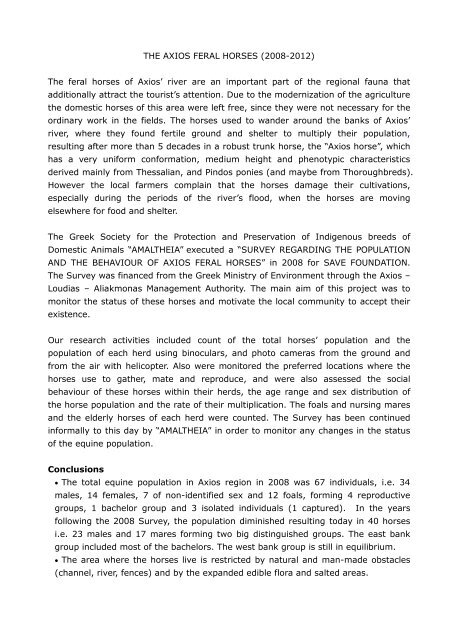
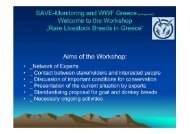
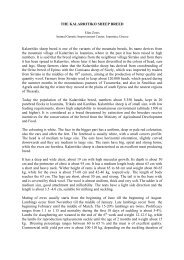
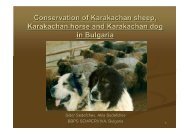
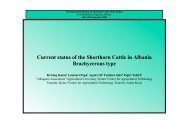


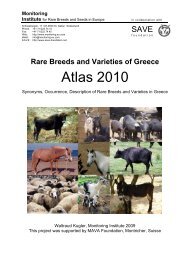

![Busha AL 2013 [Kompatibilitätsmodus] - Agrobiodiversity-Net](https://img.yumpu.com/35252125/1/190x135/busha-al-2013-kompatibilitatsmodus-agrobiodiversity-net.jpg?quality=85)
